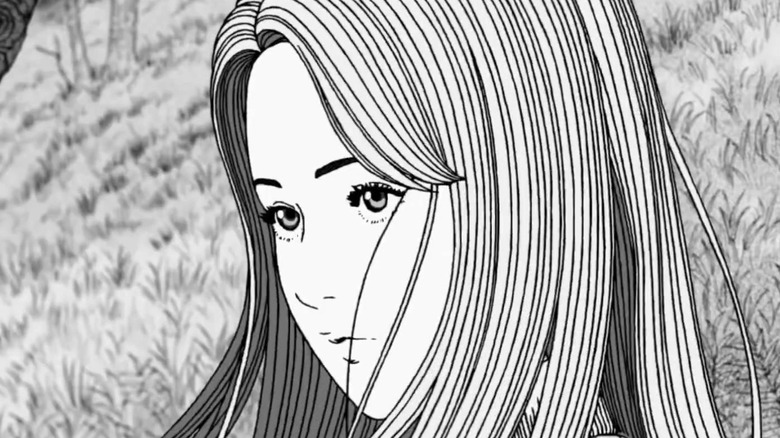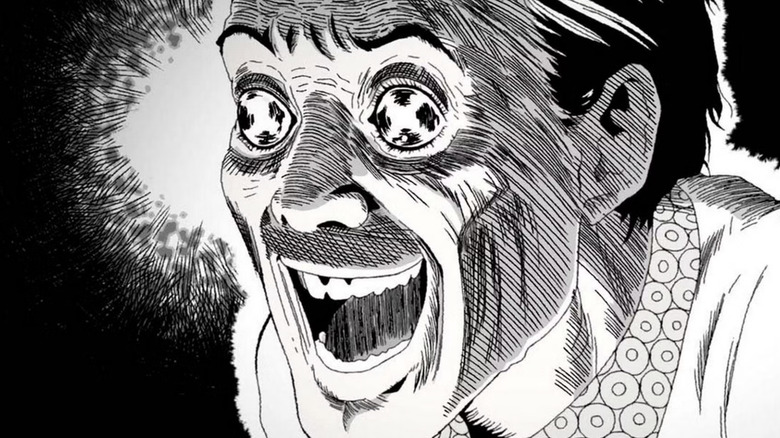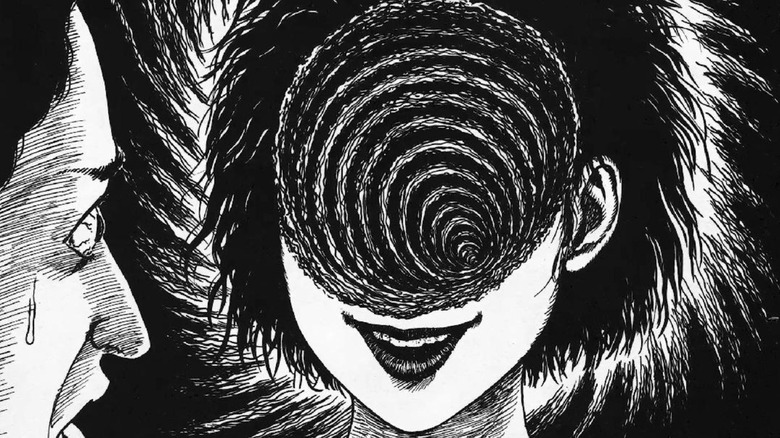Uzumaki Producer Knows Exactly What Went Wrong With Adult Swim's Adaptation
We may receive a commission on purchases made from links.
Cartoon Network's Adult Swim and Toonami programming blocks played a key role in bringing anime into the American mainstream. Now, the network just doesn't air series stateside, but it's also produced a fair bit of anime. For instance, Batman-inspired mecha series "The Big O" got a second season in 2003, co-produced by Sunrise and Cartoon Network, because the show was a big hit on Toonami.
Adult Swim is about to kick-off "Lazarus," the newest anime from "Cowboy Bebop" director Shinichiro Watanabe. But many anime fans are still reeling from disappointment towards Adult Swim's last big anime.
That would be 2024's "Uzumaki," the four-episode adaptation of Junji Ito's acclaimed 1998 horror manga. "Uzumaki" is set in Kurouzu-cho, a fictional Japanese coastal town. The town and its people, including our heroine, Kirie Goshima, are cursed, and their torments always manifest as a spiral shape. ("Uzumaki" is Japanese for "Spiral.")
Co-produced by Production I.G USA and Adult Swim, the series was first announced in 2019 and originally scheduled for a 2020 release date. It was then pushed back to 2021 before being postponed again (COVID-19 reportedly delayed the production by almost a year around this time), with nothing but a 35-second teaser to show for it. Finally, a "first look" clip of the series premiered in July 2023, over a year before the series actually debuted on Toonami in September 2024.
The delays seemed to all be worth it when the first "Uzumaki" episode proved to be quite good. It was heralded as the first successful attempt at animating Ito's comic art, leaving many eagerly awaiting the next three episodes. Then came the crushing disappointment where the animation quality plummeted.
The instant and loud backlash to "Uzumaki" episode 2 prompted a response. Jason DeMarco (co-creator of Toonami and creative director at Adult Swim) shared his side of what happened in three now-deleted posts over at BlueSky:
"It's fine, we knew this would happen. I can't talk about what went down but we were screwed over and the options were A) not finish and air nothing and call it a loss, B) Just finish and air ep 1 and leave it incomplete or C) run all four, warts and all. Out of respect for the hard work we chose C."
"After waiting so long, it makes sense people would be mad. Unfortunately I can't tell them who to blame it on ... but someone is definitely at fault here, and we all just had to do our best when things imploded. Maybe others would have made different choices. We did the best we could with what we had."
"But again, a lot of ppl worked very hard on this show and I didn't think the actions of just one or two people should be the reason it never saw the light of day. Maybe that's the wrong choice, I truly don't know. But those ppl have a right to be annoyed and disappointed. I'm glad you are digging it."
Little in the way of additional details have come to light in the six months since DeMarco's post. That includes the identities of the "one or two people" who allegedly screwed things up.
Uzumaki combined CGI, motion-capture, and animation-tracing
So, what do we know about what happened behind-the-scenes on "Uzumaki"? We know that the show swapped series directors after episode 1, handing the reins from Hiroshi Nagahama (who is still credited as a storyboard artist for all four episodes) to Yuji Moriyama. "Uzumaki" episode 1 is also credited to the animation studio Fugaku, while episode 2 is credited to a different studio, Akatsuki.
The narrative that's sprung up is that Nagahama was let go because his way of doing things was too expensive for a higher-up at Warner Bros. But while nothing like this has been confirmed, Nagahama's process was undoubtedly time-consuming, even if the results speak for themselves.
Ito draws his art to be in black-and-white, of course. His images are terrifying, sure, but they're also so gorgeously drawn and detailed that you can't look away until the fright is burnt into your brain. That's why filmmakers have historically struggled to adapt Ito's comics as in-color, in-motion anime.
As reported by Vulture, DeMarco (on the suggestion of his DJ friend Flying Lotus) and Nagahama both separately arrived at the conclusion they should make "Uzumaki" in black-and-white. That choice preserved the comic's atmosphere. As for the detail of Ito's art, Nagahama decided only a rotoscoping-like process could capture it.
"Nagahama's idea was to use motion capture and build everything in CG, then redraw all of it, which he felt would give the animators the ability to tackle Ito-sensei's line work, which is incredibly detailed," as DeMarco explained to Vulture.
Based on "Uzumaki" episode 1, that was the right choice. Just watch how the show's characters sway as they walk against or with the wind (or the way the hatching lines move with the characters they're drawn onto).
Then, compare that to the evident rush-job in "Uzumaki" episode 2. Character models are not only largely devoid of the details found in the previous episode, but they also move with unnatural slowness and jankiness, making the animation look unfinished. One scene in episode 2, featuring characters "running" along the beach, has been singled as the go-to example of this poor quality (see below):
Uzumaki Anime Sees a heavy drop in animation in episode 2.
What actually even happened??pic.twitter.com/c2aZznqsDm
— Anime News And Facts (@AniNewsAndFacts) October 6, 2024
The Uzumaki manga is a masterpiece, but the anime fell short
Some, including anime YouTuber Mother's Basement (who ran an early deep-dive into the problems of "Uzumaki"), have argued that the issues seep into the script and pacing too.
"Uzumaki" spans 20 manga chapters, and most of them are episodic, following different manifestations of the spiral curse. A cut to a woman's forehead grows into a spiral that swallows her whole. Kirie's classmates change into spiral-shelled, human-sized snails. Kirie's own hair comes alive and contorts into spiral shapes, forcing her to cut it.
This culminates in a final act where Kirie and her boyfriend Shuichi try to escape the spiral curse as it envelops the whole town. The anime, which has only four half-hour episodes, hardly does justice to the individual parts of "Uzumaki" as a whole.
"Uzumaki" ends with Kirie and Shuichi discovering the origin of the curse: an enormous "spiral entity" that lives under Kurouzu-cho. They surrender to it, cuddling together and becoming forever entwined. In keeping with the infinity of a spiral, it is said this curse has played out several times whenever people choose to live over the entity's home.
The anime, which interprets this as a literal time loop, adds an unnecessary coda showing the beginning of the next cycle (i.e. the opening of episode 1, but with new people walking in the exact same footsteps as Kirie and Shuichi). The manga wisely closes out with Kirie and Suichi's final decision instead.
Colin Stetson's score is the most consistently good part of the "Uzumaki" anime. It's eerie but subtle, establishing an uneasiness from the beginning that builds and builds (the same feeling as reading a Junji Ito comic). If only the animators had been given the time and resources to make visuals worthy of that sound.


